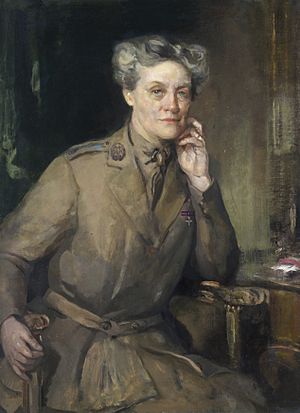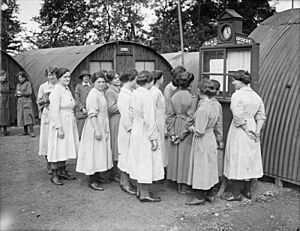Mona Chalmers Watson facts for kids
Mona Chalmers Watson (born Alexandra Mary Campbell Geddes; May 31, 1872 – August 7, 1936) was a Scottish doctor and a leader during World War I. She was the first woman to earn a special medical degree (an MD) from the University of Edinburgh.
Mona Chalmers Watson helped start the Elsie Inglis Hospital for Women. She was also the first president of the Edinburgh Women's Citizen Association. She worked as a doctor at the Edinburgh Hospital and Dispensary for Women and Children. Later, she became the head of the Queen Mary's Army Auxiliary Corps (WAAC) during World War I.
Contents
Early Life and Education
Mona Chalmers Watson was born in India on May 31, 1872. Her father, Auckland Campbell Geddes, was an engineer. Her mother, Christina Helen MacLeod Geddes, was very supportive of women's education. Mona was the oldest of five children. Her brothers included Eric Geddes and Auckland Geddes, 1st Baron Geddes.
From 1888 to 1890, Mona went to St Leonard's School in St Andrews, Scotland. Her family had a long history of interest in medicine. Her mother helped start the Edinburgh School of Cookery and Domestic Economy. She also worked to help women get medical training. Mona's aunt, Mary Adamson Anderson Marshall, was one of the first women allowed to study medicine at the University of Edinburgh in 1871.
At that time, women studying medicine faced many challenges. People often looked down on them or made rude comments.
Mona began her medical studies in 1891. She went to the Edinburgh College of Medicine for Women. This college was started by Elsie Inglis, who was also a famous supporter of women's rights. Mona graduated from the University of Edinburgh in 1896 with a Bachelor of Medicine and Bachelor of Surgery degree.
Medical Career and Achievements
After graduating, Mona Chalmers Watson worked as a doctor in London for a year. She helped mothers and babies at the Maternity District Association. She also spent six months working at Dr Barnardo's Homes in Kent.
In 1898, Mona returned to Edinburgh. She earned her special medical degree (MD) from the University of Edinburgh. She was the first woman ever to do so. Another woman, Jessie MacLaren MacGregor, received her MD in 1899.
On the same day she received her MD, Mona Geddes married Dr. Douglas Chalmers Watson. She had waited to get married until she could put "MD" after her name. They had two sons, Rupert and Irvine. After their marriage, they opened a private medical practice together in Edinburgh. They worked there until 1914.
Mona and her husband also worked on a large medical book series. It was called Encyclopaedia Medica and had 15 volumes. The first part came out in 1900. Mona helped edit the book and wrote an article about feeding sick people. They also wrote two other books together: Food and Feeding in Health and Disease (1910) and The Book of Diet (1913).
While running their practice, Mona also worked at the Edinburgh Hospital and Dispensary for Women and Children. She joined the medical staff in 1900 and later became a senior doctor there.
Mona Chalmers Watson supported the suffragettes. These were women who fought for the right to vote. She treated suffragette prisoners who had been on hunger strike.
Leading the Women's Army Auxiliary Corps
When World War I started, many women in Scotland worked as nurses or made weapons. Some drove ambulances or ran field hospitals. By 1916, Mona Chalmers Watson believed that women could do even more. She suggested creating a group of women volunteers. These women could take on non-fighting jobs to help the army.
Mona's brother, Auckland Geddes, 1st Baron Geddes, worked for the War Office. He helped Mona meet with a high-ranking army officer in January 1917. She presented her idea for a women's corps. On July 7, 1917, the Queen Mary's Army Auxiliary Corps (WAAC) was officially started. Mona was asked to be its first Chief Controller. This was a very important role, similar to a brigadier-general.
Mona asked for "every strong healthy and active woman" to volunteer. She and her deputy, Helen Gwynne-Vaughan, built a corps of over 40,000 women. About 17,000 of these women served overseas.
Mona believed that creating the WAAC was a big step forward for women. She said it was the first time women had an official role in helping the army. She wrote that it was a "great opportunity" for women to serve their country.
Mona had to leave her role in 1918 because one of her sons became ill. However, her work had a lasting impact. It helped set the stage for women's roles in the military during World War II. Her efforts led to groups like the Auxiliary Territorial Service.
For her work with the WAAC, Mona was given one of the first CBEs in 1917. People praised her for "nobly done her bit." Her portrait was later displayed in the Imperial War Museum in London.
Political Involvement
Mona Chalmers Watson was a strong supporter of women's rights. She worked to make sure women in the WAAC were paid fairly. She was a cousin of another suffragette doctor, Louisa Garrett Anderson. Mona also treated suffragette prisoners in Perth who had been on hunger strike. Many women doctors supported the right to vote.
After the Representation of the People Act 1918 gave 8.4 million women the right to vote, Mona became the first president of the Edinburgh Women Citizens' Association. This group worked hard to get more women the right to vote. They also pushed for women to have more roles in local and national government.
Mona was also involved in starting the Women's United Services Club in Edinburgh. She was its president when she died. She also helped found the Child Assault Protest Committee in 1920.
When she died in 1936, many people in Edinburgh felt her loss deeply. They wondered how women's organizations would manage without her. She had supported many societies, hospitals, and nursing boards.
Later Career and Nutrition
In her later career, Mona Chalmers Watson focused on nutrition and health. She became a member of the Advisory Committee on Nutrition. She also advised the Scottish Board of Health throughout the 1920s. In 1933, she joined the Standing Committee on Scottish Health Sciences. This committee's report helped create a unique health system for Scotland.
In 1935, she was appointed to the Advisory Committee on Diet. This committee looked into what people were eating and suggested improvements based on new knowledge about nutrition. Mona continued to fight for women in medicine. She became president of both the Scottish Women's Medical Association and the British Women's Medical Federation.
She once said it was an "honour to have lived through such great times for women." She was happy that future generations of women would not have to fight as hard for their freedom.
Fenton Barns Farm
In 1923, Mona and her husband inherited Fenton Barns farm in North Berwick, Scotland. They started raising special cattle that were tested for tuberculosis. They also created a modern dairy farm. This farm became famous across Europe for its new ideas about improving milk quality. They worked on making milk safer for children. This included studying how light affected milk and how to make milk easier for babies to digest.
Death and Legacy
Mona Chalmers Watson died on August 7, 1936. She was staying with her brother, Sir Auckland Geddes, in Kent, trying to recover from an illness.
After her death, some people felt that her contributions were not being remembered enough. A letter to The Scotsman newspaper asked why there wasn't a memorial for her, like the one for Dr. Elsie Inglis. The letter suggested creating a scholarship for women medical students in her honor.
Three years later, a memorial was created. Her co-leader from the WAAC, Dame Helen Gwynne-Vaughan, opened a special gateway at the Elsie Inglis Memorial Maternity Hospital. This gateway honored Mona Chalmers Watson's life and her service to medicine and her country.
A newspaper article about the opening said that a baby was born at the hospital right after the ribbon was cut. This happened during an air raid warning. Gwynne-Vaughan said that the gateway was "consecrated" by the birth of the baby, just as old buildings were sometimes honored by a human life.
Mona Chalmers Watson's memory is also kept alive in the archive of Memorials to Women in Scotland.
See also
 In Spanish: Mona Chalmers Watson para niños
In Spanish: Mona Chalmers Watson para niños




